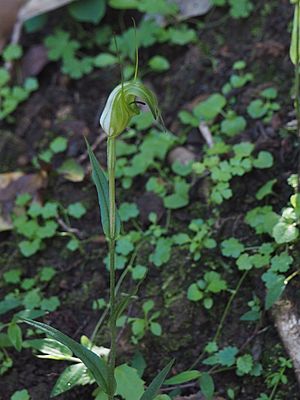Russell's greenhood facts for kids
Quick facts for kids Russell's greenhood |
|
|---|---|
 |
|
| Pterostylis russellii near Nowendoc | |
| Scientific classification | |
| Genus: |
Pterostylis
|
| Species: |
russellii
|
| Synonyms | |
|
Diplodium russellii (T.E.Hunt) (D.L.Jones) & M.A.Clem. |
|
Pterostylis russellii, commonly known as Russell's greenhood, is a special kind of orchid. It is endemic to eastern Australia, meaning it only grows naturally in that area. When these plants are not flowering, they have a group of leaves that lie flat on the ground. This group of leaves is called a rosette. But when it's time to flower, the plant grows a single, shiny white and dark green flower. This flower grows on a tall stem that does not have a rosette, but it does have a few leaves spread out along the stem.
What Does Russell's Greenhood Look Like?
Russell's greenhood is a plant that grows in the ground. It is a perennial plant, which means it lives for more than two years. It is also deciduous, so some parts of it die back each year. This plant is a herb and has an underground tuber, which is like a small storage organ.
When the plant is not flowering, it has a rosette of three to six dark green leaves. These leaves are shaped like oblongs or hearts. Each leaf is about 15 to 40 millimeters (0.6 to 1.6 inches) long and 10 to 18 millimeters (0.4 to 0.7 inches) wide.
When the plant flowers, it grows a single, shiny dark green and white flower. This flower is about 15 to 20 millimeters (0.6 to 0.8 inches) long and 7 to 9 millimeters (0.3 to 0.4 inches) wide. The flower grows on a stem that is about 200 to 350 millimeters (7.9 to 13.8 inches) tall. This stem also has three to five leaves on it.
The top part of the flower, called the dorsal sepal, and the petals are joined together. They form a hood-like shape, or "galea," that curves forward like a half-circle over the column (the central part of the orchid flower). The dorsal sepal has a thin, thread-like tip that is about 3 to 7 millimeters (0.1 to 0.3 inches) long.
The two side sepals, called lateral sepals, are held close to the galea. They have upright, thread-like tips that are about 20 to 30 millimeters (0.8 to 1.2 inches) long. There is a V-shaped gap, called a sinus, between the bases of these side sepals.
The labellum (which is the orchid's special lip petal) is about 11 to 14 millimeters (0.4 to 0.6 inches) long and about 3 millimeters (0.1 inches) wide. It is blackish in color, has a blunt end, and sticks out above the V-shaped sinus. Russell's greenhood usually flowers between April and August.
How It Got Its Name
The scientific name Pterostylis russellii was first officially described in 1952. This was done by a botanist named Trevor Hunt. He described it from a plant sample he found near Brisbane. His description was then published in The Orchid Journal (California).
The second part of the name, russellii, was chosen to honor "Mr. A.J. Russell." He was known as Captain Russell at the time and was very interested in Australian orchids. He was the first person to collect this particular species of orchid.
Where Does It Live?
Russell's greenhood grows in places that are moist and shady. You can find it in forests between Grafton in New South Wales and Gympie in Queensland.


